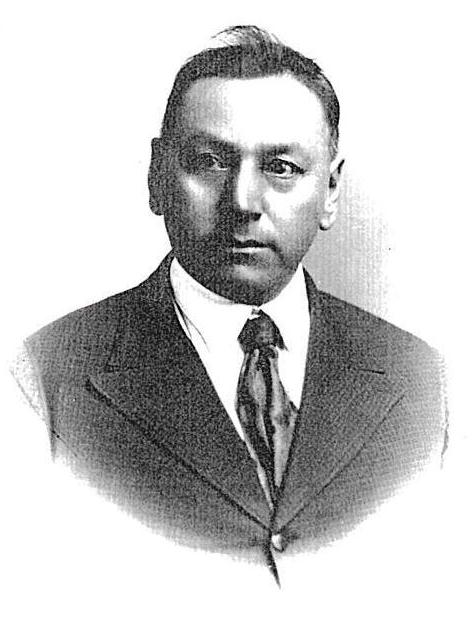|
|
Post by clarkkimberling on Jul 20, 2010 9:14:49 GMT -5
In a letter to Walter Stanley Campbell dated September 28, 1929, Robert P. Higheagle, a Lakota Indian born in Sitting Bull's camp, having been paid to interview several "old timers out on their respective reservations," wrote the following sentence: "There are other very interesting Native American stories, legends and myths among the Indians which should be preserved." Is there something in there that catches your eye? Try this: before the mid 1960s, "Native American" usually meant "originating in America". For example, here are the titles of some books which have nothing to do with Indians: Native American Anarchism, by Eunice Minette Schuster, 1932, reprinted in 1970 A Native American, by William Saroyan, 1938 Native American: the Book of My Youth, by Ray Stannard Baker, 1941 Native American Humor, by Walter Blair, 1960 Native American Balladry, by G. Malcolm Laws, 1964. Although the prevailing meaning of "Native American" before 1965 was not about Indians, there was one definite exception: the Native American Church, a name adopted in 1918 by a group of Oto, Iowa, and Arapaho tribal representatives meeting in Cheyenne, Oklahoma. This new name for their peyote-based cult was chosen to emphasize intertribal solidarity. For details and references, click en.wikipedia.org/wiki/Native_American_name_controversyand scroll down to the section headed "History". Although that Wikipedia article devotes several pages to the term "Native American", it does not satisfactorily address certain questions. I hope that contributors to American-Tribes will offer some answers. Question 1.What are some examples of early usages of "Native American" to mean American Indian? A surprisingly meagre answer from the Oxford English Dictionary, in the article on "Native", note 15, includes an earliest "known" usage, in the words "Native American churchmen" - from a letter written by Aldous Huxley in 1956. Then in 1973 and 1974, the Black Panther and New Society magazines ran relevant articles. One of these refers to the Native American Church and the others do not. Surely, there were other early appearances of "Native American" that had a greater impact on American society as a whole than those did! A related question is this: did the term "Native American" extend historically from the name of the Church (which became incorporated in 1950 as the Native American Church of North America), or was it an independent development? Question 2.Both of the terms "Native American" and "American Indian" are common today. Just think how many hours have been spent by committees, libraries, and editors trying to determine which term to use in various kinds of books and media productions. Are there any available summaries of their research and polling - especially from influential forces such as NBC, ABC, CBS, state governments, and the federal government? Regarding the latter, for example, what deliberations led to the naming of the museum: www.nmai.si.edu/subpage.cfm?subpage=visitor As another kind of example, many publishers and media forces, at various times, switched from "Indian" to "Native American". Question 2 asks for documentation of these switches in high places, including switchbacks from "Native American to "Indian". Question 3.It is said that Indians prefer to be called that, rather than Native Americans. Are there exceptions? Have there been tribes that have taken a published position on this, one way or the other? In 1929, when Higheagle was writing in a Lakota environment, was the term "Native American" in use? Question 4.Something happened in the late 1960s and early 1970s. The relatively sudden sweeping into the English language of the term "Native American" must have been driven by some powerful forces. There must have been some very influential authors, editors, and media personnel. Who were they? Now, returning to Higheagle's sentence using the term Native American in reference to Indians - way back in 1929. Did the term already have its Indian meaning - aside from the name Native American Church? That brings us back to Question 1 about early usages of "Native American" to mean American Indian, other than the Native American Church. In particular, is Higheagle's the earliest recorded usage? |
|
|
|
Post by clarkkimberling on Sept 14, 2010 14:36:35 GMT -5
The term Native American appears in several dictionaries after 1979 and style manuals after 1985. Among widely used dictionaries, one of the earliest to offer more than one paragraph is The Second Barnhart Dictionary of New English, copyrighted in 1980 by Barnhart/Harper & Row. This dictionary quotes usages by William F. Buckley, Jr., in 1973, and Margaret Mead, in 1978, and then continues as follows:
[1973] This name was popularized in the early 1970's by civil-rights activists to emphasize that the Indians were the earliest native inhabitants of America and to call attention to the discriminatory practices they were subjected to over the centuries. The new name probably derives from the designation Native American Church (known since the early 1950's)...[Actually, the Native American Church was chartered in 1918, as noted in an earlier posting.]
Ironically, the name Native American was used in the 1840's to refer to [the Native American Party], whose aim was to keep control of the U. S. government in the hands of native-born [white] citizens.
The Third Barnhart Dictionary of New English, copyrighted in 1990 by the H. W. Wilson Company, essentially repeats the entry just mentioned. Two articles in American Speech, dated 1994 and 2001, supplement the Barnhart entries with interesting early usages but do not have anything to say about the phenomenal spread of the term during the early 1970's. The findings of the articles will be described here, and then we shall return to the 1970's phenomenon. The 1994 article (see footnote 2 below), by distinguished lexicographer Sidney I. Landau, unearths usages of Native American missed by Barnhart, dating from 1925 and 1909, and arrives "at a picture of Native American as a term dating to the early twentieth century. Yet this picture is entirely wrong," writes Fred R. Shapiro of Yale University in the second article (see footnote 3). Using a "novel type of research" (via computer searching) Shapiro unearths usages of Native American -- meaning American Indian rather than the usual meaning of "originating in America" -- from these years: 1737, 1795, c.1806, 1824, 1830, 1836, 1838, 1842, 1845, 1849 (two), 1850. These usages were almost certainly not known to Robert Higheagle. We are left with the question of usages during the decade leading up to his sentence from 1929: "There are other very interesting Native American stories, legends and myths among the Indians which should be preserved." It seems to me likely the term Native American was known to Higheagle (that he didn't just make it up for the occasion) - and perhaps also known to the founders of the Native American Church, because the name was used by a magazine which neither Landau not Shapiro mentioned: The Native American, published by the Phoenix Indian School from 1900 to 1931. I'll tell more about this magazine in a later posting. Continuing with the civil-rights surge of usage of Native American in the 1970's, note that Barnhart did not report any usage prior to 1973. However, it is now easy to use Advanced Google Book to find such usages. Here's one from 1969 which was seems to have had significant impact: books.google.com/books?id=CceKpnVaVxsC&q=%22Toward+Economic+Development+for+Native+American%22&dq=%22Toward+Economic+Development+for+Native+American%22&hl=en&ei=7BCETNmmFcWOnwekkMDxDg&sa=X&oi=book_result&ct=result&resnum=1&ved=0CDEQ6AEwAA Can someone find other, similarly influential, usages from 1965 to 1970? Was this one from 1969 an important one for understanding how the term "Native American" made such a thrust into the English language in the 1970's? Footnotes and full citations: (1) The first edition of Barnhart, entitled The Barnhart Dictionary of New English Since 1963, has no entry for Native American. It was published in 1973. (2) Sidney I. Landau, " Native American: Evidence of an Earlier Use," American Speech 69 (1994) 202-206. (3) Fred R. Shapiro, "Computer-Assisted Evience for the Antquity of the Term Native American," American Speech 76.1 (2001) 109-112. Downloadable to subscribers from muse.jhu.edu/journals/american_speech/v076/76.1shapiro.html |
|
|
|
Post by clarkkimberling on Sept 16, 2010 19:08:08 GMT -5
I hope you enjoy reading this legend - there will be a short test at the end.
THE LEGEND OF THE STANDING ROCK
By Robert Higheagle
The following legend has been handed down by our ancestors and anybody who has been on the Standing Rock Reservation, no doubt, is familiar with the story it carries. There are several versions to this legend. I am giving it as it was told to me by my grandfather, when I was about six years of age, as well as from the lips of some of our older members of the Standing Rock Sioux Tribe. Many years, perhaps centuries ago - long before the advent of the White people, into this country of ours, from various parts of the world, there lived a tribe of Native Americans, in a village, on the West bank of the Missouri River, where, later, the military frontier post, Fort Yates and the Standing Rock Reservation headquarters, were established and located. In this village, there was a worthy member of the Tribe, who according to tribal custon, in those days, took upon himself two wives who were not related to each other. It was a well established fact that where women who were closely related, married to the same man, would naturally feel contented and happy in their plight. On the other hand, where two or more non-relatives jointly married to a man, they invariably, live in peace and harmony, but of course, since there is an exception to almost every rule, it was a general opinion, that the parties concerned in this particular union apparently got along peaceably. But one dark day, there came some trouble between them which was caused by an uncontrollable circumstance, affecting jealousy and dissatisfaction on the part of the junior wife. The husband politely rebuked her for this - much against his will. Instead of raising a disturbance in the family, she arose early one morning, dressed and painted herself up, (as if she were going to some tribal gathering) and with her pet dog following, proceeded to the side of the hill, not far from their tepee. Upon her arrival there, she sat down on the green grass, in the customary position of an Indian woman in trouble or distress, pulled up her blanket, covered her head completely, leaving only an opening around her eyes, from which she could see everything that transpired while she was sitting there. On this memorable day, breakfast was prepared by the senior wife and when all was ready, she called the junior wife, addressing her as "sister" to breakfast but still she sat there motionless. It was useless for the husband to entreat her to come back to the lodge. They finally gave up calling her. Sometime after breakfast, the camp crier announced the latest order from the chief, for the people to break camp at once, and move toward North to a place designated - supposedly twenty-five miles away. The people started to pull down their tepees and the young men were driving home the ponies for the people in the camp. Within two hours or so, thereafter, the whole camp was moving and some already on the way. The woman and her pet dog were called and called preparatory to the exodus of the tribe, but to no avail. At last the husband said; "maybe it would be best to leave her alone and let her act upon her own inclinations in the matter." Nevertheless they took their time, pulling down their tepee and packing up their worldly belongings and were about to leave the camp - thinking she might join them, but still she did not move. No one, outside of this noted family knew anything about this family trouble. So they continued on their way without her. At this juncture, seeing that the wife did not follow, as was expected, the husband became very much worried and alarmed about her. He made arrangements to have his family proceed with the rest of the tribe on their sojourn while he went back to the wife left behind. He did not wish her to be left in a dangerous plight, especially during the night. Taking with him a brother of the missing wife and an extra riding pony, they rode back where she was last seen. Upon nearing the place, they saw her at the exact same spot where she was, much to their astonishment and disappointment. They were now in deep mourning and at once, sang songs of lamentations and wept over what had happened to their beloved one. They hurried back to the camp and reported to the chief and the people what had transpired with the missing wife. The transformation of the missing wife into a sold rock was proclaimed in the camp and there was now a tribal mourning. The chief ordered that the tribe move back to where the Great Spirit had thus performed such a miracle on one of the members of the tribe. They broke camp at once and returned to the place which was afterwards their stomping grounds for a long time. The tribe manifested a great deal of reverence toward this petrified woman. The rock was later moved and placed on a pedestal on the edge of a bluff, in front of the Agency office building - overlooking the mighty Missouri River with its waters flowing down toward South for ages past and ages to come. The petrified pet dog was evidently, stolen or else appropriated as a souvenir by someone who heard of the legend of the Standing Rock. Source Indians at Work, vol. 3, no. 8, 1935, page 30-31. This magazine appeared every two months during 1933-1945. It was published by the U. S. Bureau of Indian Affairs and the U. S. Office of Indian Affairs. Test 1 (easy). Why does Higheagle's account belong in this thread? It could have been posted at the main Higheagle thread instead: amertribes.proboards.com/index.cgi?board=teton&action=display&thread=9902 (hard). Who was Higheagle's grandfather mentioned in the first paragraph? Answers 1. Higheagle uses the term Native American - in 1935! Unlike his 1929 usage, this one was published - many years before the term was thrust into mainsteam English by non-Indian forces. 2. It appears that this grandfather was not the man mentioned in Kingsley's reply #17 at amertribes.proboards.com/index.cgi?board=teton&action=display&thread=990, who died in 1862. Another candidate, about whom it is written that "High Eagle, Chief of the Great Council Lodge, was killed in the Reno fight, June 25, 1876," would have been gone by the time Robert was old enough to receive the story from him. Clark Kimberling |
|
|
|
Post by clarkkimberling on Sept 26, 2010 14:30:40 GMT -5
Yet another pre-1969 usage of Native American or native American - other than Native American Church, has emerged, in addition to Robert Higheagle's usages in 1929 and 1935. This one occured in 1936. What the author, Raymond Higheagle, son of Robert Higheagle, had to say may be of general interest, so I'll quote the whole article.
FIRST AID AND RED CROSS SERVICE AMONG THE SIOUX, YESTERDAY AND TODAY
by Raymond Higheagle, Standing Rock Agency, North Dakota
The American Indian was commonly considered to be "the noble red man of the forest and the great outdoors." He was gifted with a fine physique. He seemed immune from the ravages of many major diseases, and was hardly ever plagued with the milder ones so common at the present time. The question which confronts the minds of those who do not know or understand the native American is with what or how did he combat these ailments during his primitive state?
The Indian was a real child of nature. When in sickness and in trouble, he turned to nature for relief. To this end, certain herbs and roots which the Great Mysterious intended should be used to give relief, and which possessed healing powers for certain ailments of mankind were studed by medicine men of the tribe through observation, experiment, dreams, visions and prayers. The medicine man was required to be of unblemished character, otherwise his medicines would fail him.
[Photograph appears here; see the note below.]
For the preservation and safe-keeping of these precious herb and root medicines, special bags or pouches in bead and porcupine quill work were made by the most skillful hands. "The sacred bundles" were recognized as objects of reverence by the Indians. Every member of the Sioux Tribe was familiar with the remedies such as calamus, anise roots and other common herbs and roots for emergency use. In every family these remedies were kept constantly on hand for administering first aid.
In the days gone by, when our people, the Sioux Indians, lived in their old way, the "Mini Aku" (They go, bring back and give water) organization carried on work in some ways similar to the great work maintained by the present Red Cross. This was a young women's organization. The chief of the tribe, through the council, conferred membership in the organization to every qualified young woman or girl in the tribe. Every member must be prepared when called upon to go after, bring back and administer water and aid to the needy, particularly to the wounded warriors, the aged, the sick and those in distress. Thus our Sioux people, in their simple way, understood the need of first aid and maintained an organization to help those who were less fortunate.
In the primitive life of the Sioux Indian as well as in these modern times it behooved everyone, as a sense of duty, to acquire some knowledge of how to meet an emergency. The Great Mysterious alone knows what will happen to us or to our neighbor within the next minute of our lives. In our Government schools and in particularly the higher institutions of learning, the teaching of first aid is sometimes correlated with other subjects.
It was my good fortune to be among the young men who took the IECW Short Course in First Aid held last summer at Pierre, South Dakota. The valuable instructions given me and the knowledge I acquired shall be a lasting inspiration to me.
Footnotes: 1. The article was published in Indians at Work, volume 4, number 8, 1936, pages 44-45. 2. The photo shows twenty-three participants, perhaps including Raymond Higheagle. The caption is "First Aid Class Demonstration At Fort Wingate School, Fort Wingate, N. M." Would anyone like to see the photo posted later in this thread? There's a certain archive that may have the original - if so, permission would probably not be a problem. Or perhaps someone already has an electronic copy? Clark |
|
|
|
Post by clarkkimberling on Oct 14, 2010 17:31:20 GMT -5
This thread began with a note that Robert P. Higheagle used the term Native American many years before the term became the now familiar near-synonym for American Indian. The thread continued with a formulation of questions aimed at tracing the channels of influence up to Higheagle's usages and then in connection with the phenomenal growth of usage during the early 1970s. This present note gives evidence that there was a particular channel of influence which has been overlooked by researchers. They seem to have been unaware of American Indian sources. It seems likely that a publication named The Native American was known to those who chose the name Native American Church in 1918, and that Higheagle was in a position to be familiar with both the publication and the Church. The Native American was published from 1900 to 1931 by the Phoenix Indian School. The first issue, dated January 13, 1900, shows the following paragraph on its first page: "The Native American" The Native American? Who is he? The Indian, of course; the red man who stood upon the shores of America, gazing in wonder at the pale-face stranger who came in 1492; the red man who cried, "Welcome!" to the disheartened Pilgrims and shared with them, during that first hard winter, his Indian corn, the gift of the Great Spirit, Gitche Manitou, the Mighty. So now again, at the beginning of 1900, the voice of the Native American sends forth its greeting. May the new year bring peace and progress. Under the motto "Not for school but for life," The Native American was first edited by Samuel M. McCowan, the superintendent of the Phoenix Indian School. In order to weigh the influence of the publication, especially as regards spreading the term Native American to mean Indian (rather than its much more common meaning of originating in America), it will be helpful to describe the publication. For its first two years, The Native American consisted of four two-column pages and was published each week during the school year. McCowan established regular columns consisting of news regarding students, teachers, and school activities, as well as correspondence from other Indian schools, articles about tribes, and biographical articles about superintendents of Indian schools. On January 1, 1902, Charles W. Goodman became superintendent of the Phoenix Indian School and editor of The Native American. During Goodman's editorship until 1915, the publication grew to eight pages. On April 1, 1915, John Brookings Brown became the editor. The next October, The Native American began appearing every two weeks, more as a magazine and less as a newspaper. At that time the magazine had a circulation of about 3,500. Significantly for our purposes, the magazine featured articles of widespread interest on tribes, education, disease, workers, health, Indian affairs in general, World War I, liquor, and patriotism. Littlefield and Parins write that Many of the articles were written by scholars, government officials, and others not associated with the school. Brown also published special numbers emphasizing such themes as the day school, health, Arizona State Fair, and commencement. Finally, Brown took a strong editorial stand, producing editorials on topics as widely ranging as the Grand Canyon, democracy, personality, the Ku Klux Klan, music, drama, war, football, and Christmas.
Annual or commencement numbers contained student writing, and each regular issue contained a lead article by someone not affiliated with the school, such as Stanley Vestal, Frances Densmore, Henry Roe Cloud, or M. K. Sniffin. Regarding those four writers, recall Higheagle's connections with Stanley Vestal (pen name of Walter Stanley Campbell) and Frances Densmore (author of Teton Sioux Music), as described at amertribes.proboards.com/index.cgi?board=teton&action=display&thread=990Footnotes: 1. The information about The Native American is taken from Daniel F. Littlefield, Jr., and James W. Parins, American Indian and Alaska Native Newspapers and Periodicals, 1826-1924, Greenwood Press, 1984, pages 321-326. 2. Robert A. Trennert, Jr., in The Phoenix Indian School: Forced Assimilation in Arizona, 1891-1935, University of Oklahoma Press, 1988, writes that "The paper was touted as providing educational benefit, but its real purpose was to publicize the school within the local community. For that reason, its contents were closely regulated and nothing unfavorable to the school or the assimilation program was tolerated." Nevertheless, Tennert goes on to say that "as time passed the paper also became an important vehicle for providing the Indian community with information about current and former students." |
|
|
|
Post by clarkkimberling on Oct 15, 2010 11:42:54 GMT -5
As a promoter of the term Native American, Samuel M. McCowan's experience in journalism and Indian education are of interest. Information recorded in Portrait and Biographical Record of Arizona, Chapman Publishing Company, 1901, indicates that, beginning in 1889, McCowan was superintendent of the day schools on the Rosebud reservation in South Dakota.
In 1890 he was offered the choice of the superintendency of three different Indian schools, but availed himself of the request of the commissioner of Indian affairs that he open a new Indian school at Mohave, Ariz. During the six years of his devotion to the interests of the school at Mohave, his salary was twice raised, and at the expiration of the time of service he was promoted to the superintendency of the Indian school at Albuquerque, N. M. At the end of six months he received a still further mark of appreciation, being appointed supervisor of all the Indian schools in the United States. This responsible position he later resigned in order to take charge of the Indian Industrial School at Phoenix, with which he has been associated since 1897...
[On] November 16, 1900, he became managing editor of the Arizona Republican...
The Phoenix Indian school with which Mr. McCowan is connected is the second in size in the United States. During the year 1899 nearly seven hundred students attended the school, representing more than fifty different tribes, Professor McCowan believes that there is no height to which the Indian may not attain, and under his own observation they have become scientific farmers, representatives in congress, soldiers in the army, and have excelled in the professions of law and medicine. They have also made names for themselves as artists and musicians. The girls develop into excellent trained nurses and cooks, and some are successful as teachers...
It seems likely that McCowan chose the name of The Native American, thereby possibly starting - or continuing - a chain of links. The links probably led to Robert Higheagle's awareness of the term in 1929. They probably extended to the dramatic increase of usage in the early 1970s, and hence, to present-day usage by millions of speakers and writers. Here is a copy of the first page of the first issue The Native American: 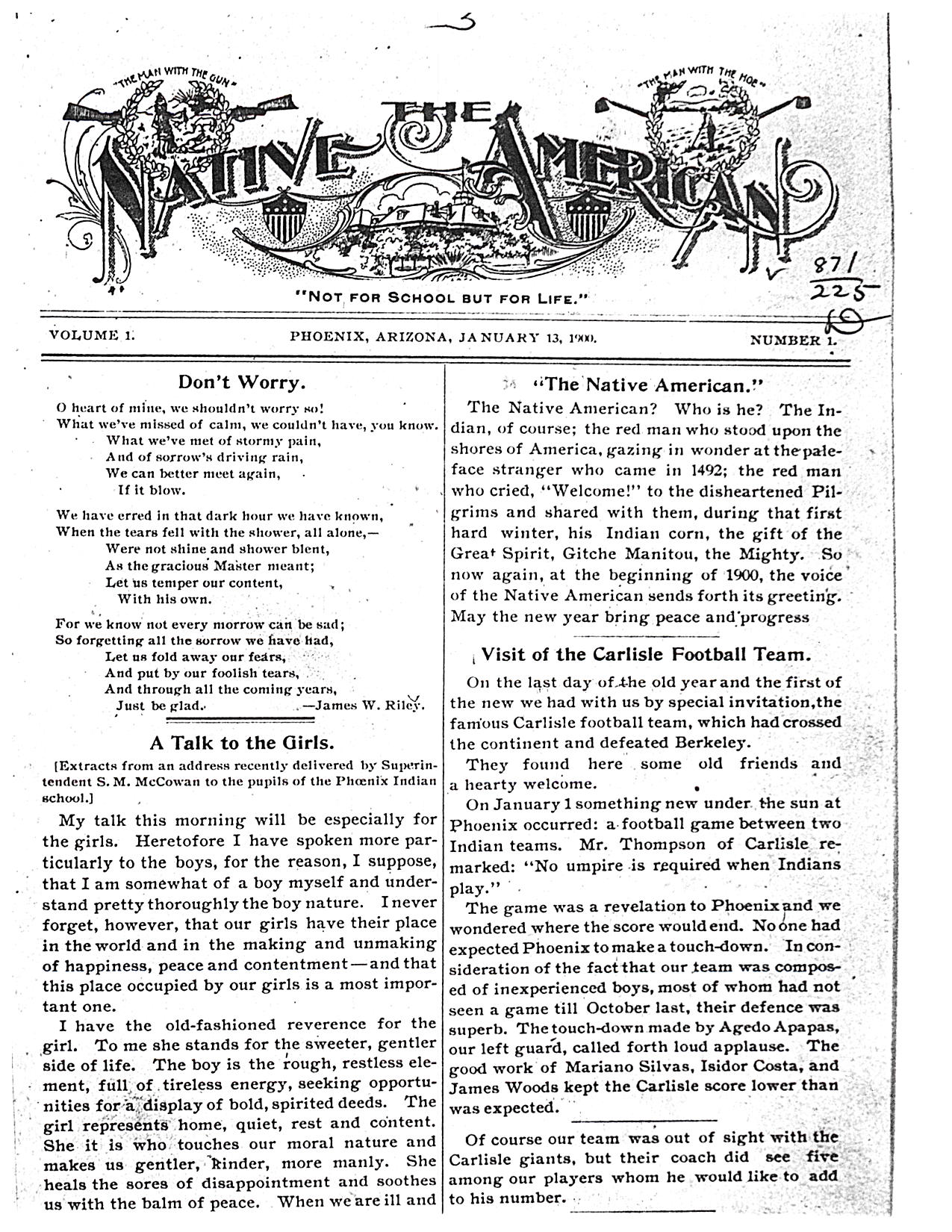 Attachments:
|
|
|
|
Post by clarkkimberling on Oct 26, 2010 13:40:14 GMT -5
In order to trace influences leading to Robert Higheagle's familiarity with the term Native American decades before the term came to mean essentially American Indian instead of the usual originating in America, we have seen that the term appeared in the title of The Native American, published from 1900 until 1931. Replies 4 and 5 just above tell something of the history of The Native American. Over its run of three decades, many front cover designs were used. A few of them are shown here: 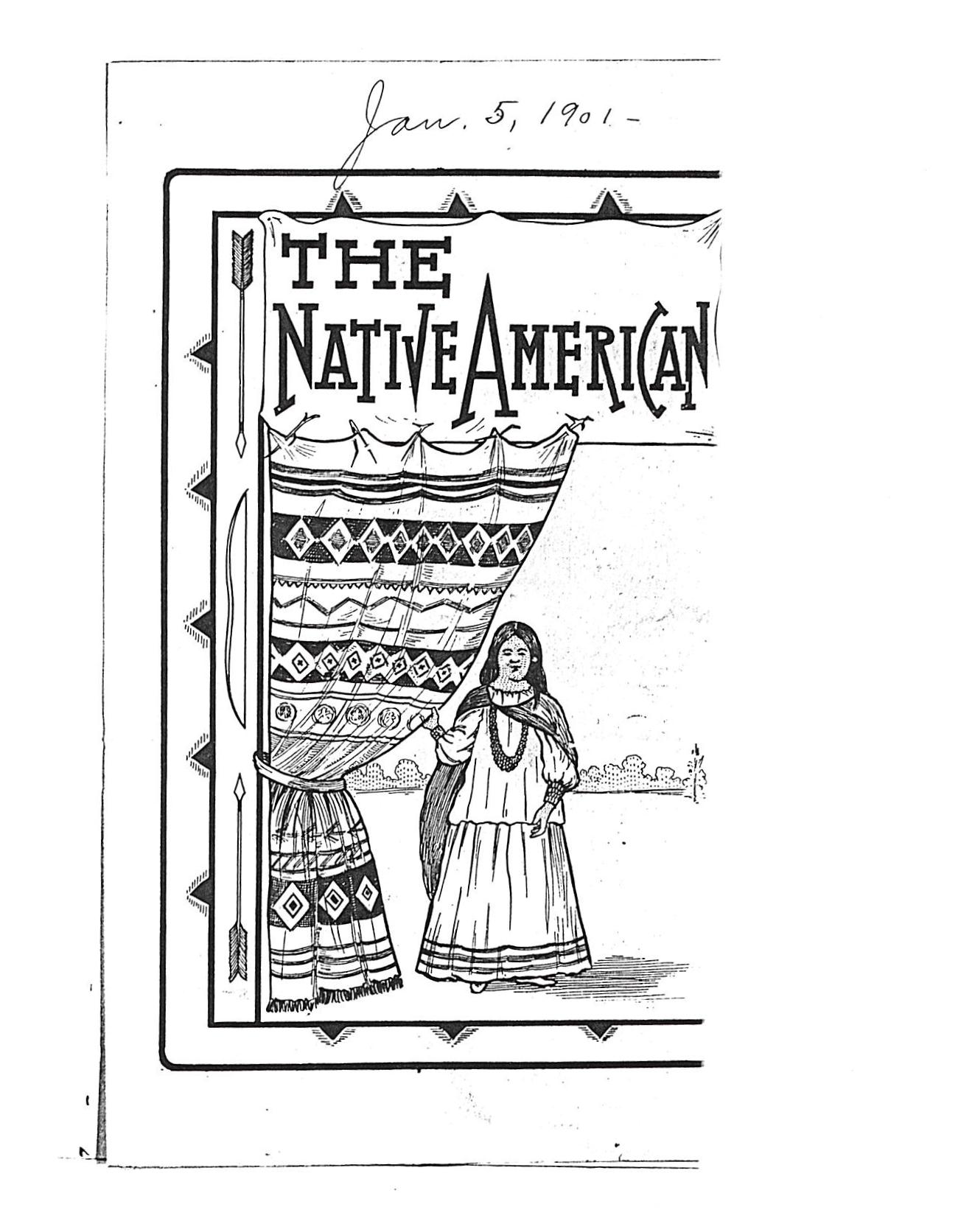  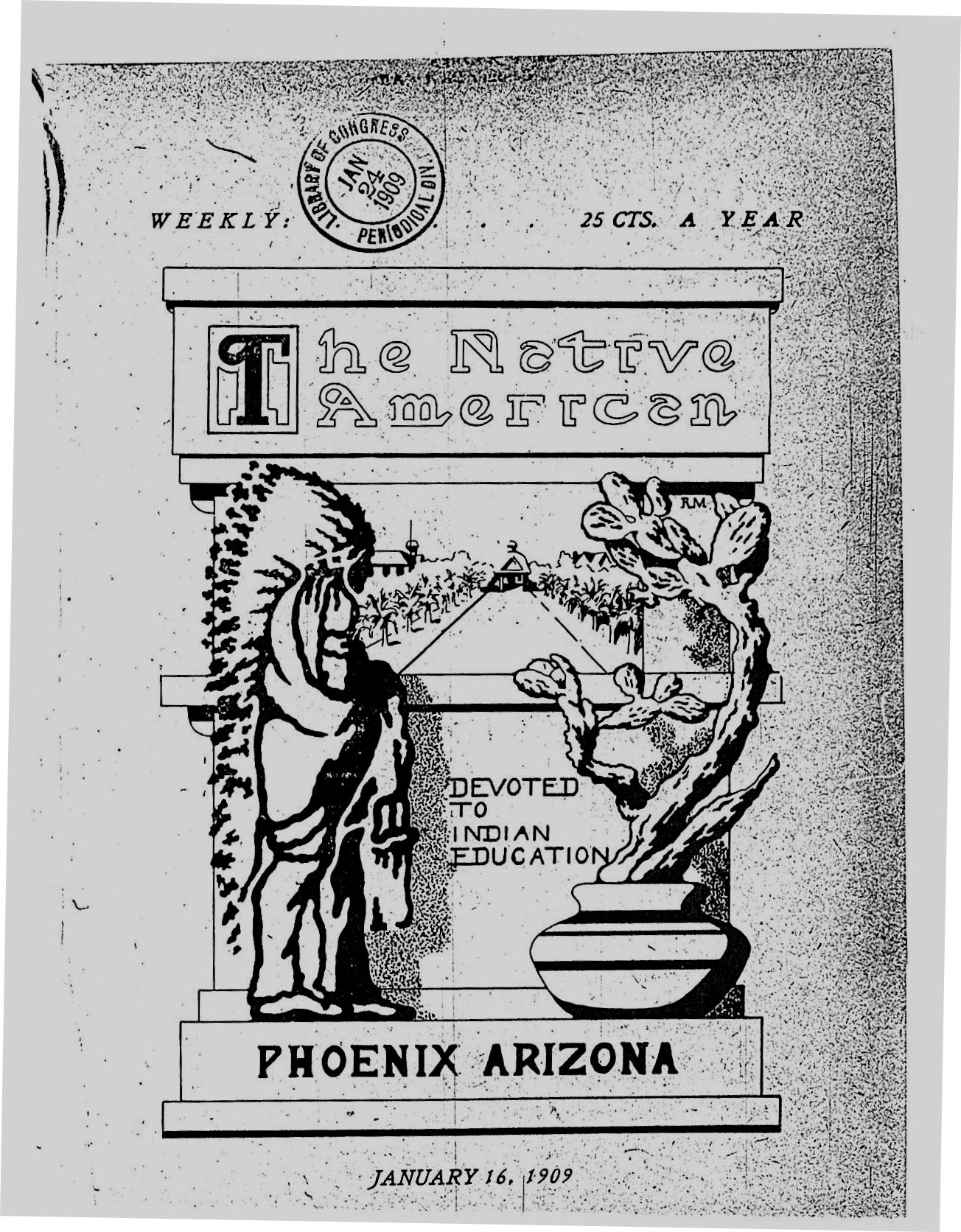  By 1916, The Native American reached a circulation of about 3500. Also in 1916, The Native American ran a "Brief History of Phoenix School" and "The Growth of Our Magazine", reproduced here: 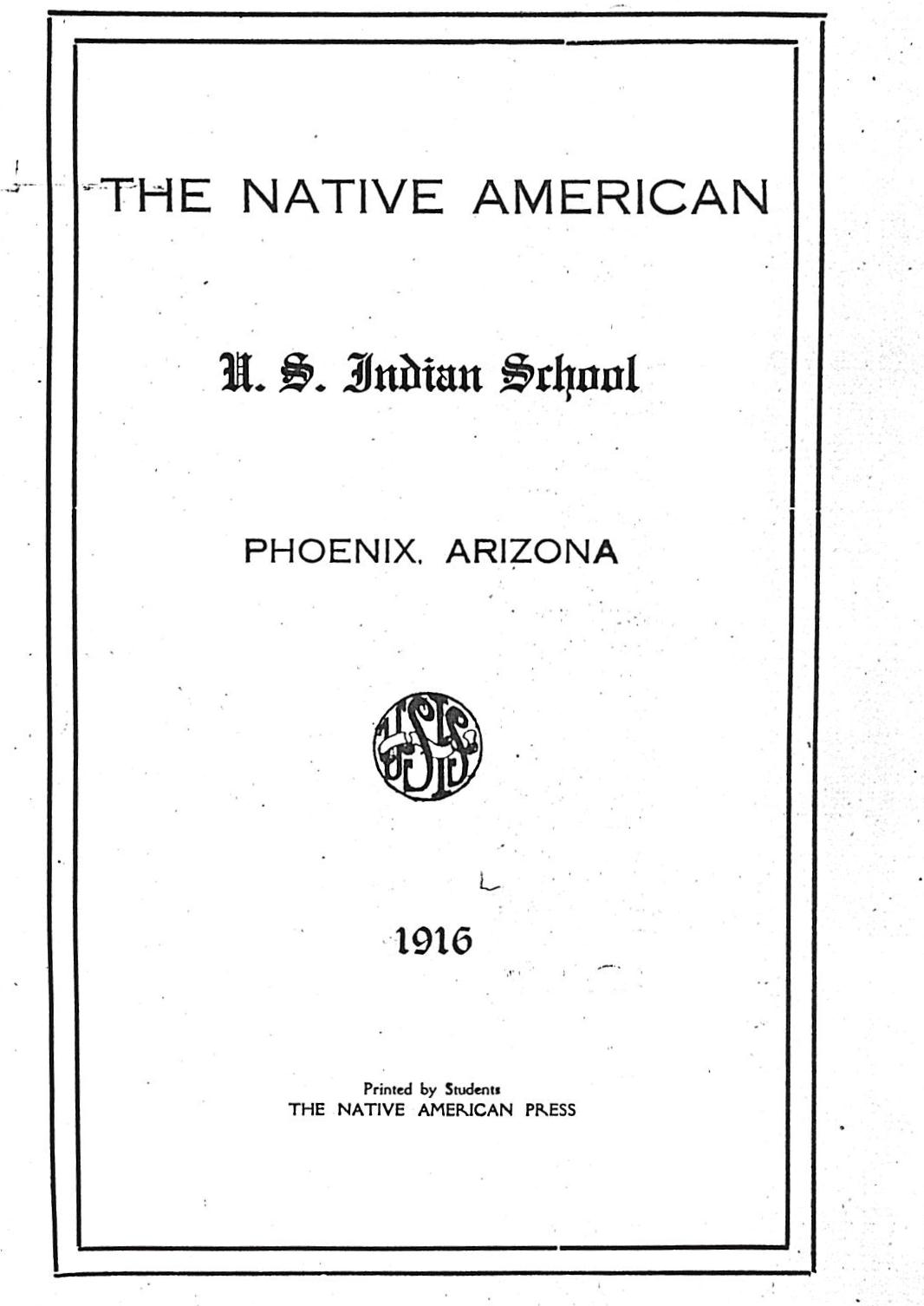 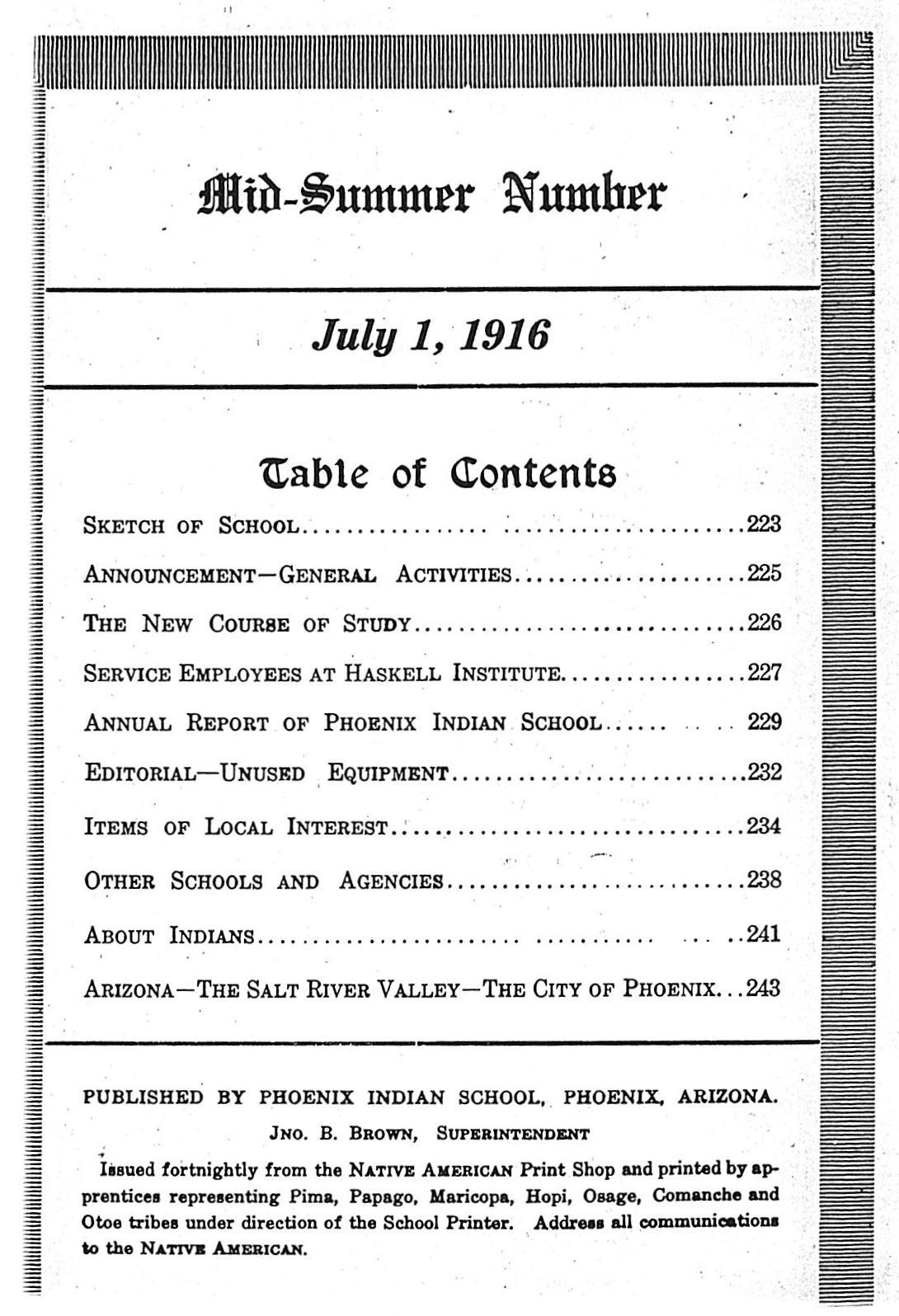  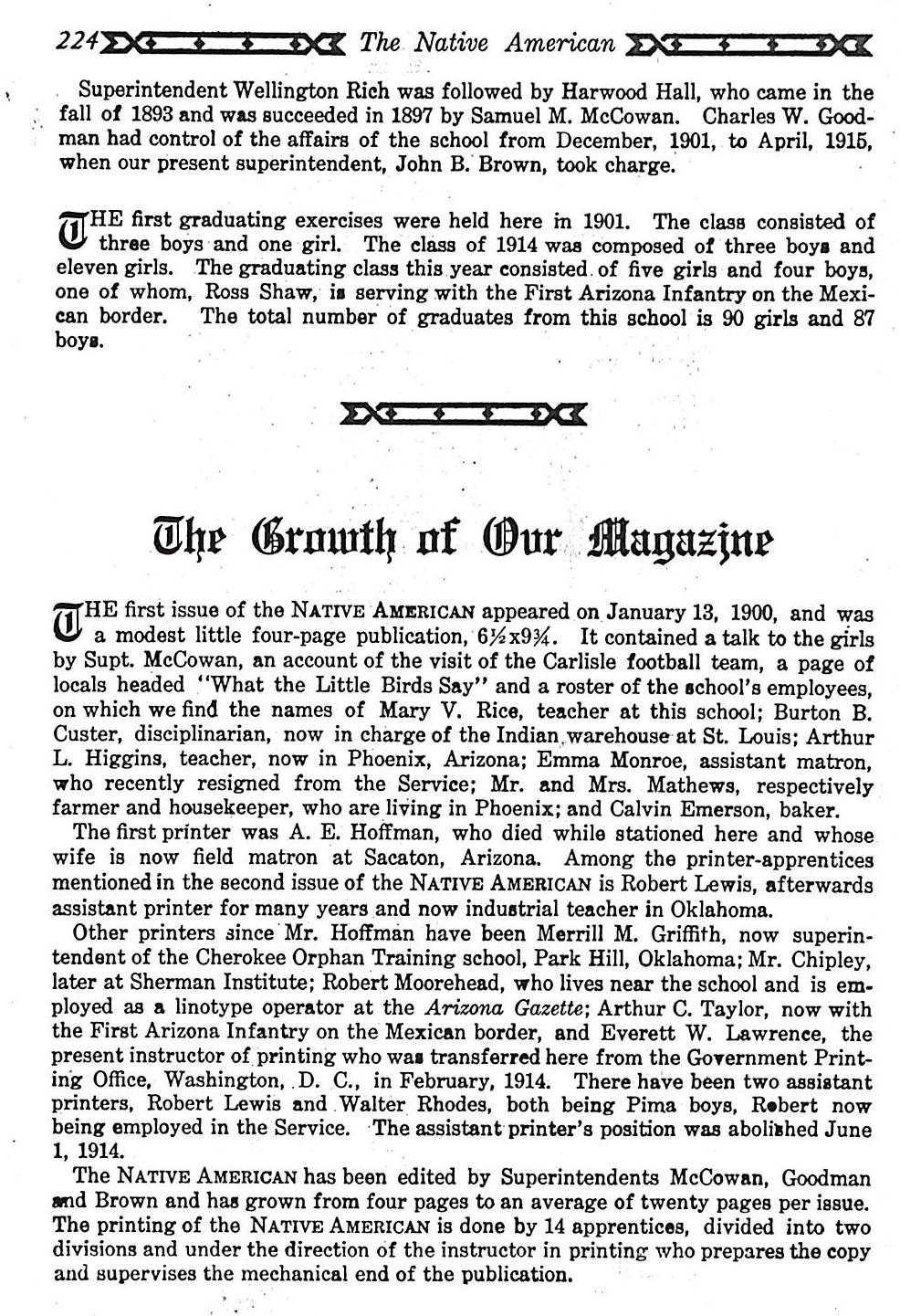 A third development in 1916 took place in Oklahoma. There, members of the Peyote Cult were finding it desirable to adopt a different name, and by 1918 they had decided on Native American Church. It seems likely that the members were well aware of, and perhaps influenced by, the name of The Native American. No doubt, Higheagle was aware of the Native American Church, which had made its way to Standing Rock Reservation during the years before Higheagle wrote "Native American" in 1929. Footnotes:1. In 1931, The Native American was replaced by The Redskin. A history of both publications, including the circulation estimate of 3500, is given by Daniel F. Littlefield, Jr., and James W. Parins, American Indian and Alaska Native Newspapers and Periodicals, 1826-1924, Greenwood Press, 1984, pages 321-326. 2. A history of the Peyote Cult and early years of the Native American Church are presented in Weston La Barre, The Peyote Cult, Fourth Edition Enlarged, Archon Books, 1975. (Originally published by Yale University Press, 1960.) |
|
|
|
Post by clarkkimberling on Dec 26, 2010 15:27:27 GMT -5
Earlier postings have established that Robert Higheagle and his son Raymond both used the term Native American to mean American Indian, rather than the prevalent meaning, years before the prevalent meaning gave way to the Indian meaning in the early 1970s. This present posting will support the view that Higheagle became familiar with Native American through his awareness of the Native American Church. Also, as a teacher, he may have been aware of the 1900-1931 school publication entitled The Native American. In a letter dated April 4, 1934, Higheagle wrote from Little Eagle, South Dakota, to John Collier, Commissioner of Indian Affairs, in Washington, D. C.
Dear Mr. Collier:
I am writing you pursuant to our conversation at the Plains Indian Congress at Rapid City, South Dakota during your visit there.
You will recall that I acted as one of the interpreter at that Congress and while there talked with you relative to my filling the position, now vacant, as farm agent at Shields on the Standing Rock Indian Reservation in North Dakota.
At the time that we talked this matter over you requested that I write you setting forth my qualifications and my ability to handle this position and also at the same time suggested that rather than take the civil service examination perhaps it would be best for me to fill that position as a laborer rather than as a regular Government Farm Agent.
I was born on the Standing Rock Reservation in 1876. I completed a grammar school education, graduated from high school and first year of college work. After completing my education I accepted a position on the Brule Reservation as assistant teacher in a boarding school at that place. I taught day schools on the Standing Rock, Crow Agency, Pine Ridge and at Devils Lake extending over a period of 20 years.
After that I received an appointment, after passing the examination, for departmental clerk on the Standing Rock Reservation at Fort Yates, North Dakota which position I held for six years. For the following four years I acted as assistant cashier of the McLaughlin State Bank and field man for the Continental Land Company which position gave me a wide field of experience. The following four summers I worked as interpreter for the Bureau of Ethnology of the Smithsonian Institute and at the same time I acted as temporary District Farmer at Wakpala and Bullhead both on the Standing Rock Reservation. During 1929 I acted as bookkeeper for the Black Hills Utility Company. After that I worked with the University of Oklahoma in the preparation of a book on the life of Sitting Bull. From that time to this I have been Indian Judge on the Standing Rock Reservation in South Dakota.
I always held other positions and done other work which I believe will help me in qualifying as a Farm Agent in understanding the needs of my fellow Indians and helping them with their problems. I assisted in surveying the Standing Rock Reservation at the time the land was alloted. I worked with the University of Oklahoma in making a survey of the use of Peyote. My experiences as teacher among the Indians and my experiences as Indian Judge and also my experiences as interpreter in Federal Court, Circuit Court, County Court, Justice Court and also at Tribal councils, to say nothing of the experiences of my representing the Indians of this and other reservations on Tribal affairs on eight different trips to Washington, D. C., where I appeared before the Senate Committees, House Committees and the Department of Interior.
My reason for asking for this position is that the position of Indian Judge carries with it a fee of only $30.00 per month which with the cut of 15% makes it almost impossible for me to live and support my family. Also, the position does not require all of my time and I am desirous of getting some work which will require my entire time as I have been very active all of my life and I am not content unless I am busy. I feel that even at my age I am more than competent to handle this position and that my varried experience has well qualified me for this position.
Thanking you for considering my application for this position. I remain,
Yours very truly,
(signed) Robert Higheagle
Higheagle's letter indicates his familiarity with the peyote cult with the sentence "I worked with the University of Oklahoma making a survey of the use of Peyote." Although this is not a direct mention of the Native American Church, it can be established that Peyote was nearly synonymous with that Church in Higheagle's circles, as evidenced by the following article in the McLaughlin Messenger, January 5, 1923: Peyote Worship Banned In South Dakota By Opinion
Amendment to Articles in Denied the Native American Indian Church
In an opinion given by Attorney General Byron S. Payne it is held that...
This opinion is written as the result of inquiry made by George F. Sayers, assistant secretary of state, who states that his office is in receipt of articles of incorporation from another "Native American Church", in which articles it is stated that peyote is to be used from sacramental purposes....
It seems likely that Higheagle was a subscriber to the McLaughlin Messenger - recall his mentioning his employment at the McLaughlin State Bank. In any case, I now rest my case that the term Native American (meaning American Indian) received a big boost beginning in 1900, that the person responsible for that usage was the first editor, Samuel M. McCowan, of The Native American, that the namers of the Native American Church were already familiar with the term Native American as a result of the 1900-1931 publication of that name, and that Higheagle was aware of the term as a result of his familiarity with the Native American Church, if not also the 1900-1931 publication. And one more thing: that earlier attempts to trace the history of the American Indian meaning of the term Native American were flawed because they overlooked Native American sources. NotesI have included the entire Higheagle-Collier letter because it gives biographical details not found elsewhere. The letter is archived in NARA Record Group 146. From the same repository comes this photo of Robert P. Higheagle: |
|












